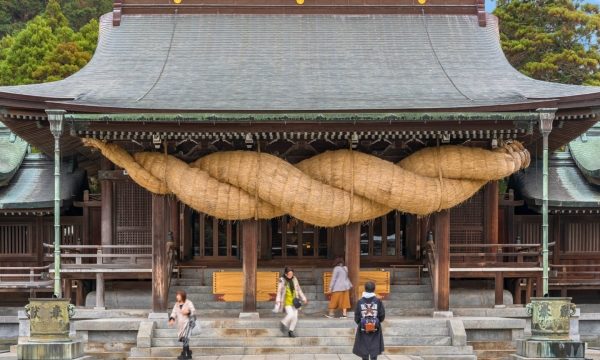
Shinto shrines in Japan are more than just architectural wonders; they embody a deep spiritual connection between humanity and nature. Each shrine tells a story, echoing the whispers of ancient traditions that have been meticulously preserved over centuries. From the majestic torii gates that mark the transition from the mundane to the sacred, to the serene gardens that invite contemplation, these spaces are imbued with a timeless beauty that draws visitors from around the world.
As one wanders through the tranquil paths of a Shinto shrine, the air is thick with reverence and history. The rhythmic sounds of clanging bells and soft rustling leaves create a meditative atmosphere, encouraging reflection and peace. Here, in the embrace of towering trees and delicate architecture, one can experience a profound connection to the spiritual essence of Japan, making a visit to these shrines an unforgettable journey into the heart of the country’s rich cultural heritage.
The Significance of Shinto Shrines
Compare Options
Shinto shrines in Japan serve as vital cultural and spiritual landmarks, embodying the essence of Japanese spirituality and tradition. These sacred spaces are dedicated to kami, the divine spirits that are believed to inhabit all aspects of nature. Each shrine acts as a gateway between the human world and the realm of the kami, offering a place for prayer, reflection, and communion with the divine. They are not only sites of worship but also repositories of the stories and practices that shape Japan’s identity.
The architecture of shinto shrines is also deeply significant, reflecting the connection between nature, the spirit world, and the Japanese people. The design is often minimalistic yet elegant, harmonizing with the surrounding environment. Elements such as torii gates, which mark the entrance to sacred spaces, and the use of natural materials symbolize purity and a respectful relationship with nature. This design philosophy emphasizes simplicity and tranquility, making shinto shrines a sanctuary for those seeking peace and spiritual connection.
Moreover, shinto shrines play a crucial role in community life, often hosting festivals and rituals that strengthen social bonds and cultural heritage. Events such as the Matsuri festivals bring together local residents to celebrate their traditions, highlight seasonal changes, and honor the kami. These gatherings are vital for the preservation of cultural practices, fostering a sense of belonging and continuity among generations. Through these vibrant communal activities, shinto shrines remain central to the spiritual and social fabric of Japanese society.
Architectural Marvels: Design and Structure
Shinto shrines in Japan are remarkable examples of traditional Japanese architecture, reflecting a deep reverence for nature and spirituality. The most common materials used in their construction are wood and thatch, chosen for their availability and harmony with the environment. This organic approach not only allows the structures to blend seamlessly into their surroundings but also embodies the Shinto belief in the sanctity of nature. Shrines are often elevated slightly above the ground, allowing for proper drainage and symbolizing a bridge between the human and divine worlds.
The layout of Shinto shrines is characterized by a unique design known as "sacred space." Typically, a torii gate marks the entrance to the shrine, signifying the transition from the mundane to the sacred. Within the grounds, various structures are arranged around a central honden, or main hall, which houses the shrine’s kami, or spirit. The use of asymmetry in design and the principle of "ma" or negative space fosters a sense of tranquility and contemplation, inviting visitors to pause and reflect on their surroundings.
One of the most striking features of Shinto shrines in Japan is their intricate decorative elements. Carvings and motifs often depict natural themes, such as animals and plants, echoing the belief that all elements of nature are intertwined with the divine. The roofs of these shrines are typically adorned with unique styles, from the thatched roofs of older shrines to the elegant curves seen in more contemporary designs. This aesthetic not only serves a functional purpose, but it also enhances the spiritual ambiance, creating an enchanting experience for all who visit.
Cultural Rituals and Festivals
Shinto shrines in Japan are not only places of worship but also centers of cultural celebrations and rituals deeply embedded in Japanese society. Throughout the year, various festivals, known as matsuri, are celebrated at these shrines, drawing locals and visitors alike. Each matsuri often corresponds with the seasons, agricultural cycles, or significant events in the Shinto calendar. These lively gatherings showcase traditional music, dance, and costumes, allowing communities to come together to honor their deities and express gratitude for the blessings received.
Among the most famous festivals is the Gion Matsuri in Kyoto, celebrated in July, which features elaborate floats, processions, and various rituals held at Yasaka Shrine. Similarly, the Kanamara Matsuri, held in Kawasaki, has gained international attention as a celebration of fertility and marital harmony. These events reflect the diverse nature of Japan’s cultural heritage, with Shinto practices intricately woven into the fabric of local life and tradition. Participation in these festivals fosters a sense of community and continuity, connecting the present with the past.
In addition to large-scale festivals, many shrines hold smaller, more intimate rituals that mark the passage of time in individual lives, such as the Shichi-Go-San celebration for children or the New Year celebrations. These customs allow families to seek blessings for health, prosperity, and protection, reinforcing the personal connection between the individuals and the spiritual world represented by Shinto shrines. The vibrant tapestry of these rituals and festivals ensures that the timeless beauty of Shinto shrines remains alive in the hearts of the Japanese people.
Preserving Tradition in Modern Japan
In the bustling landscape of contemporary Japan, Shinto shrines stand as profound symbols of cultural heritage and spiritual resilience. Amid rapid modernization, these sacred places preserve rituals and practices that have persisted for centuries. They serve not only as places of worship but also as guardians of history, allowing the traditions of the past to live on in the present. The intricate architecture, the meticulously maintained gardens, and the annual festivals all reflect a commitment to honoring Japan’s spiritual ancestry.
The role of Shinto shrines extends beyond religious observance; they also foster community and belonging. Local residents often engage in shrine activities, from festivals to seasonal celebrations, reinforcing ties within communities. These events breathe life into the shrines, drawing people of all ages to participate in age-old customs. Through these interactions, younger generations gain an appreciation for their heritage, ensuring that the teachings and values embedded in Shinto practices are passed down, even as the world around them evolves.
As Japan continues to navigate the complexities of modern life, the preservation of Shinto shrines is a testament to the nation’s dedication to its roots. Efforts to maintain these sites involve careful restoration, educating visitors about their significance, and promoting sustainable tourism. This balance of tradition and modernity allows Shinto shrines to thrive, ensuring that they remain vibrant centers of worship and cultural identity for years to come.


